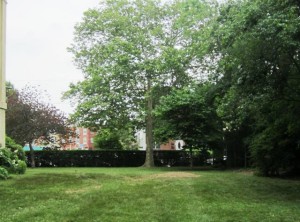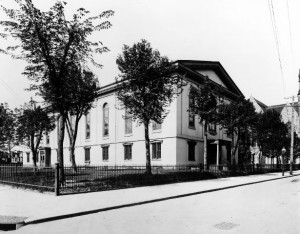Originally written by David Hewitt on the blog Growing History; adapted by Wagner’s Cara Scharf
North Philadelphia, with its closely packed houses and shops, cracked sidewalks and streets, and vacant lots and overgrown parks, is not necessarily where you’d expect to find a historic landscape.
 It’s there, however, in the yard of the Wagner Free Institute of Science. Though there are many historic plants in the yard, some of the most noticeable are the large trees such as London planes (Platanus x acerifolia) and silver maples (Acer saccharinum) that ring the yard. Their size alone suggests they have been here for a while, but how long and where did they come from?
It’s there, however, in the yard of the Wagner Free Institute of Science. Though there are many historic plants in the yard, some of the most noticeable are the large trees such as London planes (Platanus x acerifolia) and silver maples (Acer saccharinum) that ring the yard. Their size alone suggests they have been here for a while, but how long and where did they come from?
The first question is reasonably straightforward to answer. To find out how old a tree is, you either cut it down and count its rings or you take a core sample and count the rings that way. The latter leaves the tree standing, so Wagner faculty member David Hewitt, Ned Barnard, a fellow historic tree enthusiast and author of New York City Trees, and a few others used an 18” corer to take a long, narrow piece out of both a London plane and a silver maple in the Wagner’s yard in October 2011. Both trees were found to be in the range of 110 or 115 years old.
 Once the age was narrowed down, Hewitt went to the Wagner’s archives to see if he could find record of the Wagner acquiring the trees. He found that they likely came from a nursery owned by Thomas Meehan in the Germantown section of Philadelphia, and were added around the turn of the 20th century. Meehan was a significant figure in 19th century botany and horticulture, founding two horticultural publications and working for Bartram’s Garden before he founded his own nursery business which planned many notable gardens including the Vanderbilt Mansion in Hyde Park, New York, and the English Garden at the Cummer Museum of Art in Jacksonville, Florida. In a letter from Thomas Meehan (dated February 22, 1900) he mentioned that he had been ill. He died in 1901, so the Wagner yard may well be the last landscape he worked on.
Once the age was narrowed down, Hewitt went to the Wagner’s archives to see if he could find record of the Wagner acquiring the trees. He found that they likely came from a nursery owned by Thomas Meehan in the Germantown section of Philadelphia, and were added around the turn of the 20th century. Meehan was a significant figure in 19th century botany and horticulture, founding two horticultural publications and working for Bartram’s Garden before he founded his own nursery business which planned many notable gardens including the Vanderbilt Mansion in Hyde Park, New York, and the English Garden at the Cummer Museum of Art in Jacksonville, Florida. In a letter from Thomas Meehan (dated February 22, 1900) he mentioned that he had been ill. He died in 1901, so the Wagner yard may well be the last landscape he worked on.
History is everywhere, and so are plants. The two are intertwined, and even in the middle of the city they tangle together, and the one can tell us about the other, the trees can tell us what was there before, and what was there before tells us about the trees that are there today – and even though they may be layered over and it may take some digging and coring, they all have something to say, and they all can say it, if you just look.
In addition to the Wagner, Philadelphia is rich with examples of historic plants and gardens such as Bartram’s, Wyck Historic House and Garden, the Schuylkill Center, Fairmount Park, etc. Take some time, while the weather is still conducive to outdoor activity, to check some of these sites out!
About the Growing History blog: This is the blog of “Growing History: The Philadelphia Historic Plants Consortium”. The consortium links institutions, creating a network of gardens and historic plants with materials propagated from the sites themselves. Plants exchanged will serve as material for education in their shared history, in science, and conservation. The blog disseminates the stories behind the plants and the landscapes they occupy.
About the Wagner Free Institute of Science: The Wagner is a Victorian-era natural history museum and has been a provider of free science education since 1855. Visitors are welcome Tuesday through Friday, 9 to 4 pm, though please note the museum will be on a summer break and closed to the public the last two weeks in August (17th through the 28th). If you’re interested in spending time in our historic yard, join us for the Honey Happy Hour, part of the 6th Annual Philadelphia Honey Festival, on Friday, September 11th from 5 to 7 pm. More details on this event can be found here.
